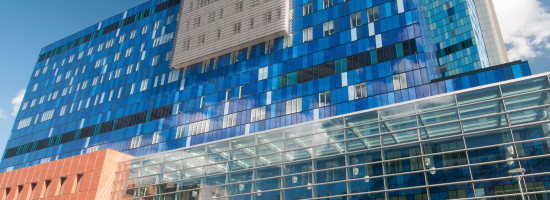The Royal London Hospital is one of the oldest teaching hospitals in the UK, located on Whitechapel Road, Whitechapel in the London Borough of Tower Hamlets. It is currently part of Barts Health NHS Trust, which across its four hospitals boasts one of the best survival records in the NHS.
The Royal London Hospital treats more injury patients per year than any other centre in Britain (1,400+). The Royal London also has the busiest children’s A&E in the capital, and is unique in emergency care for having a resident A&E Department consultant available 24 hours a day, seven days a week.
London’s Air Ambulance
London’s Air Ambulance (a.k.a. London HEMS – Helicopter Emergency Medical Service) is based at the Royal London Hospital, which has a helipad on the roof. It responds to serious trauma emergencies in the London area. A helicopter can reach any patient inside the M25 within 15 minutes, and carries a senior doctor in addition to a paramedic. The charity operates 24 hours a day, and can deliver life-saving surgery at the scene.
History
Founded in 1740 as the London Infirmary, the hospital was established to serve the rapidly growing population of the east side of London, which at that time had no other voluntary hospitals, while the rest of the city was served by five (St Barts, Guy’s, St Thomas’, St George’s and Westminster). In 1741, the hospital was moved from its original site on Featherstone Street, Moorfields, to a larger site on Prescott Street – a poor district whose buildings were in poor condition – and changed its name to London Hospital in 1748. It took a decade to acquire the funds to buy the current site in Whitechapel, construct the new hospital and move the staff and patients in (1757).
The Royal London Hospital has several claims to fame. While private medical schools had existed long prior to its foundation, the London Hospital Medical College (founded 1785) was the first in England and Wales to be connected to a hospital – a practice that continues to the modern day.
Joseph Merrick, better known to the world as “the Elephant Man” spent the last years of his life at the hospital, under the care of his friend, the surgeon Dr Frederick Treves.
The epithet “Royal” was added to the name of the hospital in 1990, when Queen Elizabeth II visited the hospital as part of its 250th anniversary celebration.
The history of both the hospital and of medicine in the East End is exhibited in the Royal London Museum and Archives, located on site, in the crypt of a 19th century church. It includes displays on the Elephant Man, First World War nurse Edith Cavell, who formerly worked at the hospital, and forensic medicine, including the famous Jack the Ripper murders.
Future
A massive redevelopment project is underway to expand the Royal London Hospital. With £1 billion investment, the hospital is planned to become London’s leading trauma and emergency care centre. It will have one of Europe’s largest renal services and London’s second biggest paediatrics unit.
Royal London Hospital address:
The Royal London Hospital
Whitechapel Road
Whitechapel
London
E1 1BB
How to get to the Royal London Hospital
- Whitechapel tube station is nearby (Hammersmith & City and District Lines; London Overground).
- Liverpool Street is the closest railway station.
- Buses 25, 106, 205, 253 and 254, and night buses N25, N106 and N253 stop on Whitechapel Road, close to the hospital.
- Buses 15, 115 and D3 stop on Commercial Road
- Cycling is encouraged if possible, and there are cycle parking facilities around the hospital.
Royal London Hospital parking
The Royal London Hospital does not have public parking facilities, and patients and visitors are encouraged to use public transport when visiting. However, there is a limited number of disabled parking spaces for drivers with Blue Badges, which can be reached via Raven Row.
There is limited metered parking on the streets around the hospital for those who need to drive, including Turner Street, Ashfield Street, Cavell Street and Varden Street. The Royal London is just outside the congestion charging zone.
